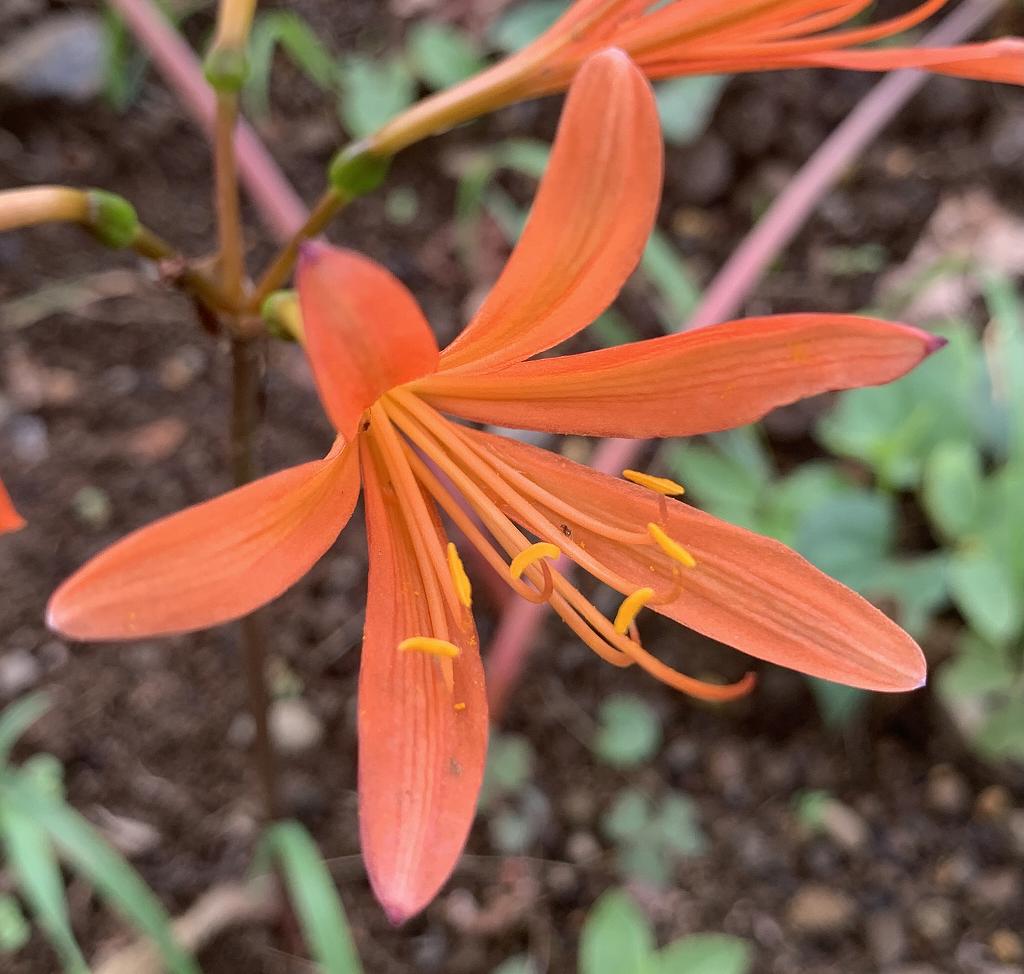キツネノカミソリは薄暗い林床に花茎だけをスッと伸ばし、先端で枝分かれして橙赤色の花を複数つけます。花言葉は「妖艶」です。
Lycoris sanguinea grows only flower stalks on a dimly lit forest floor and branches at the tip to produce multiple orange-red flowers. The flower language is “bewitching”.
【仮名】キツネノカミソリ, テッショクセン
【和名】狐の剃刀, 鉄色箭
【英名】Lycoris Sanguinea
【学名】Lycoris sanguinea
【誕生】08/ 30
【開花】08月
【花色】Orange


キツネノカミソリ
キツネノカミソリの分布、自生
キツネノカミソリはヒガンバナ科の多年草です。日本と朝鮮半島に分布し、林床や林縁に自生。まだほかの草が生えない早春に細長い葉を伸ばし、多くの草が茂る盛夏に葉を落とします。
キツネノカミソリの名前の由来
キツネノカミソリの名前の由来は細長い葉の形が剃刀に似ているから。または、花色がキツネを連想させるから。葉なしで花が咲くところが奇異で、キツネに化かされたように感じるから。
キツネノカミソリの花言葉
キツネノカミソリは旧盆の頃、薄暗い林床に花茎だけをスッと伸ばします。先端で枝分かれして橙赤色の花を複数つけます。その妖しいほどに艶めかしい姿から、花言葉は「妖艶」です。
キツネノカミソリとヒガンバナ
キツネノカミソリは、葉の伸長と開花が別々で、植物体が有毒であるところは、近縁のヒガンバナと同じ。違うのは場所で、ヒガンバナは人里に生え、キツネノカミソリは森林に生えます。
キツネノカミソリとワスレグサ
キツネノカミソリは、食用されたり薬草として利用されるワスレグサに見た目が似ています。しかし、ヒガンバナと同様にリコリンなどの有毒成分を含むので決して口にしてはいけません。
Lycoris Sanguinea
Distribution of Lycoris sanguinea, native
Lycoris sanguinea is a perennial plant of the Amaryllidaceae family. It is distributed in Japan and the Korean Peninsula, and grows naturally on the forest floor and forest edges. It grows elongated leaves in early spring when other grasses do not grow yet, and drops them in midsummer when many grasses grow.
Origin of the name Lycoris sanguinea
The name Lycoris sanguinea comes from the elongated leaf shape that resembles a razor. Or because the flower color is reminiscent of a fox. It’s strange that the flowers bloom without leaves, and it feels like a fox.
Lycoris sanguinea flower language
Lycoris sanguinea grows only flower stalks on a dimly lit forest floor during the old Bon festival. It branches at the tip and has multiple orange-red flowers. The flower language is “bewitching” because of its mysteriously glossy appearance.
Lycoris sanguinea and cluster amaryllis
Lycoris sanguinea has separate leaf elongation and flowering, and the plant is toxic, which is the same as the closely related cluster amaryllis. The difference is the location, cluster amaryllis grows in remote areas, and Lycoris sanguinea grows in forests.
Lycoris sanguinea and daylily
Lycoris sanguinea looks similar to the daylily, which is edible and used as a medicinal herb. However, like cluster amaryllis, it contains toxic components such as lycorine and should never be eaten.


